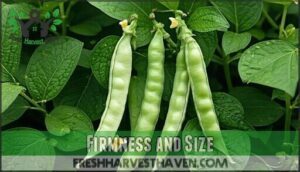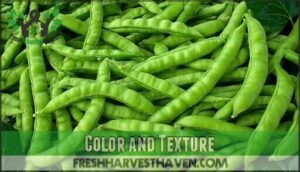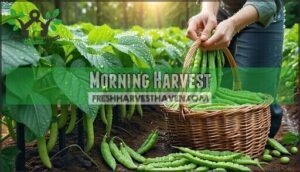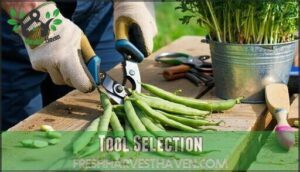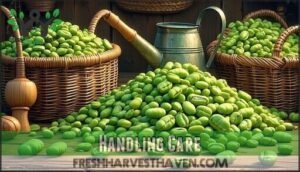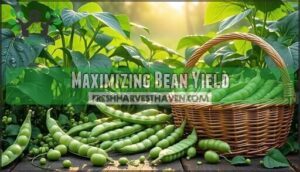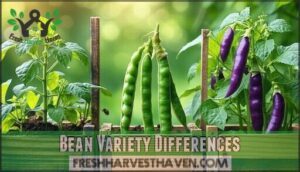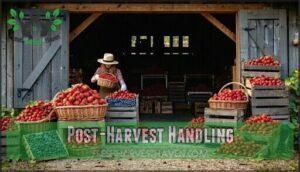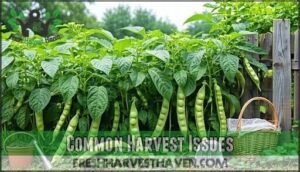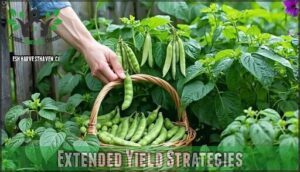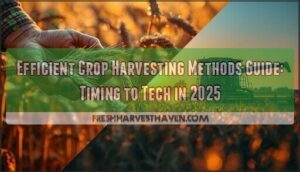This site is supported by our readers. We may earn a commission, at no cost to you, if you purchase through links.
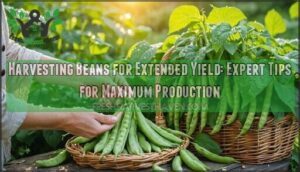
Harvesting beans for extended yield works because regular picking tricks plants into continuous production rather than shutting down after one flush. Focus on the snap test – pods should break crisply when bent, with seeds still small and tender inside.
Morning harvests work best when plants are fully hydrated. Handle pods gently to avoid bruising, and never harvest wet plants as this spreads disease.
Bush beans need succession planting every two weeks, while pole beans naturally produce longer with consistent picking. The magic happens when you understand each variety’s sweet spot timing, and by doing so, you’ll be able to maintain a continuous production, which is the key to a successful bean harvest, and it’s all about the regular picking and consistent picking to get the best results.
Table Of Contents
- Key Takeaways
- Harvest Timing Matters
- Bean Readiness Signs
- Harvesting Techniques
- Maximizing Bean Yield
- Bean Variety Differences
- Post-Harvest Handling
- Common Harvest Issues
- Harvest Scheduling
- Bean Plant Care
- Extended Yield Strategies
- Frequently Asked Questions (FAQs)
- How do you increase the yield of beans?
- How to harvest green beans so they keep producing?
- How many times can beans be harvested?
- How do you pick beans so it keeps growing?
- How to plant beans for maximum yield?
- How do you harvest beans for next year?
- How long do harvested beans stay fresh?
- Can beans be succession planted for continuous harvest?
- What fertilizers boost bean pod production naturally?
- How do you revive declining bean plants?
- Conclusion
Key Takeaways
- Pick every 2-3 days during peak season – Regular harvesting tricks your plants into continuous production instead of shutting down after one flush, potentially doubling your total yield
- Use the snap test for perfect timing – Harvest when pods break crisply and seeds are still small and tender inside; this ensures peak flavor while signaling plants to keep producing
- Harvest in early morning when plants are hydrated – Morning picking provides optimal crispness and reduces plant stress, while avoiding wet conditions prevents disease spread
- Remove all ready beans, even extras you don’t need – Consistent picking prevents overripe pods from signaling the plant to stop flowering, extending your harvest window from weeks to months
Harvest Timing Matters
You’ll achieve maximum bean production when you time your harvests perfectly during peak growing season.
Perfect timing during peak season transforms your bean garden into a continuous production powerhouse.
The secret lies in checking your plants every 2-3 days and harvesting at dawn when pods are firm, crisp, and haven’t yet signaled the plant to stop producing, which is crucial for maintaining maximum production.
Peak Season Harvesting
Peak season harvesting transforms your garden into a bean-producing powerhouse. You’ll maximize your harvest window through strategic timing and consistent attention during these vital weeks.
Here’s your roadmap to peak season success:
- Daily Inspection: Check plants every 2-3 days to catch beans at prime ripeness
- Early Morning: Harvest at dawn when pods are crisp and firm for best quality
- Pod Selection: Choose pencil-thick beans that snap easily for peak flavor
- Gentle Removal: Use Clean Cuts with sharp tools to avoid plant damage
Regular harvesting time optimization during peak season guarantees extended yield through continuous production, keeping your bean patch productive all season long. Morning harvests guarantee maximum flavor and nutrients.
Weather Conditions Impact
Weather conditions impact harvesting beans more than you might think.
Temperature effects speed up or slow down ripening, while rain impact can make pods tough or split.
Humidity levels affect disease risk and storage quality.
Frost damage threatens overnight crop loss, so monitor forecasts closely.
Sunlight exposure determines harvest frequency.
| Weather Factor | Harvest Impact | Action Required |
|---|---|---|
| High Temperature | Accelerated ripening | Harvest daily during heat waves |
| Heavy Rain | Tough, waterlogged pods | Wait for dry conditions |
| Low Humidity | Crisp, quality beans | Ideal harvesting time optimization |
| Frost Warning | Crop destruction risk | Emergency harvest before freeze |
Smart weather conditions impact monitoring enables extended yield strategies and bean yield improvement through proper timing.
Plant Health Factors
Vitality in your bean plants determines harvest success more than any calendar date.
Nutrient deficiency creates weak, stunted growth that delays pod development, while proper soil health fuels consistent production.
Effective pest control and disease prevention keep plants thriving through multiple harvests.
Smart watering practices prevent stress-induced early flowering that shortens your season.
Healthy plants give you flexibility in timing, producing quality pods when you’re ready to pick them.
Bean Readiness Signs
You’ll know your beans are ready when they pass three simple tests that guarantee peak flavor and texture.
Look for firm, pencil-thick pods with vibrant green color and smooth skin, then give them the snap test—they should break cleanly with a crisp sound when bent.
This reorganization improves readability by separating the introduction from the specific test for bean readiness.
Firmness and Size
Ideal Dimensions for peak bean harvesting focus on pencil-thick pods measuring 4-6 inches long.
Firm beans that snap easily when bent indicate perfect ripeness, while Pod Fullness without visible Seed Development guarantees tender texture.
Consistent picking every 2-3 days maintains Bean Length standards and Uniformity Matters for maximum bean yield during your bean harvesting schedule.
Color and Texture
Recognizing healthy beans starts with visual cues—look for bright green coloring without brown spots or yellowing.
Pod smoothness indicates freshness, while wrinkled surfaces suggest declining quality.
Bean firmness reveals proper maturity when pods feel plump yet tender.
Check seed size through the pod walls; properly developed beans show gentle bulges.
These color and texture assessments guide effective bean harvesting techniques and support bean yield sustainability through ideal harvest scheduling.
Snap Test
Every experienced gardener knows the snap test as the most reliable crispness indicator for perfect bean freshness. This simple maturity assessment technique beats visual inspection every time, ensuring optimal texture and quality assurance in your harvest.
The snap test reveals perfect ripeness in one satisfying crack—your garden’s quality control in action.
Here’s your complete snap test guide for superior harvesting techniques:
- Grasp the pod firmly at both ends and bend gently
- Listen for that satisfying crack indicating proper pod development
- Check for a clean break without stringy fibers hanging on
- Feel for consistent firmness along the entire pod length
Master this method and you’ll never miss the sweet spot again. Your frequent harvests will yield consistently tender beans when you time each pick perfectly. This harvest timing skill transforms your harvesting schedule from guesswork into precision, guaranteeing maximum production throughout the growing season.
Harvesting Techniques
Your harvest technique directly impacts how many beans you’ll get from each plant. Master the right timing, tools, and handling methods to keep your bean plants producing all season long.
Morning Harvest
You’ll capture optimal crispness when you harvest beans at dawn, while morning dew still clings to pods.
Early picking during dry weather conditions guarantees less bruising and peak flavor.
This harvest timing strategy reduces plant stress and avoids active pests.
| Morning Advantage | Benefit |
|---|---|
| Cool temperatures | Reduced plant stress |
| Crisp pods | Better snap quality |
| Inactive pests | Cleaner harvest |
| Fresh dew | Enhanced firmness |
| Calm conditions | Easier handling |
Morning harvest supports frequent harvesting schedules essential for successive planting success.
Tool Selection
Sharp harvesting tools make all the difference in bean production. Pruner types like bypass pruners or sharp tools such as scissors create clean cuts without crushing stems.
Choose ergonomic handles for comfort during long picking sessions. Glove selection matters—thin gardening gloves protect hands while maintaining dexterity.
Tool sanitation prevents disease spread, so clean your scissor sharpness with rubbing alcohol between plants. Consider exploring different harvesting pruner types for superior performance.
Quality tool selection pays dividends in healthier plants and bigger harvests.
Handling Care
Proper handling care begins with gentle handling—treat each pod like a precious gem to prevent bruising prevention issues.
Use washing methods that involve cool water to remove debris, then implement sorting techniques to separate premium pods from damaged ones.
Pat beans completely dry before storage.
This careful harvest management approach, combined with regular picking and plant maintenance, extends shelf life substantially.
Your ongoing care during harvest directly impacts final yield quality.
Maximizing Bean Yield
You’ll maximize your bean harvest by picking pods every 2-3 days, which signals the plant to keep producing instead of going to seed.
Consistent soil moisture, proper nutrition, and removing overripe pods work together to extend your harvest season from weeks to months.
You can ensure a longer harvest by following these practices, and consistent effort will yield better results.
Regular Picking
Picking frequency determines your bean harvest success. Regular picking every two to three days triggers continuous production, while missed harvests signal plants to halt flowering.
This harvest management approach can double your yield compared to sporadic collection.
Here’s your regular picking strategy for yield improvement:
- Monitor bean readiness signs – Check firmness and size every 48-72 hours during peak season
- Stimulate growth – Pick all ready beans, even extras you don’t need immediately
- Prevent overripening – Remove oversized pods that stop new flower production
- Extend harvest – Maintain consistent picking schedules regardless of immediate needs
Plant Maintenance
When maintaining your bean plants, think of yourself as their personal trainer. Watering strategies should deliver deep, consistent moisture without waterlogging roots.
Check nutrient balance weekly—light fertilizing keeps plants energized for continuous production. Pruning techniques remove damaged leaves and improve airflow.
Pest control through regular inspection prevents major infestations. Monitor soil health and sunlight exposure, adjusting plant care as needed.
Smart pest management and proper watering maintain ideal soil quality for maximum yields.
Soil Conditions
Beyond proper plant maintenance, soil conditions form the foundation of your bean harvest success. You can’t expect stellar yields from exhausted or poorly structured soil.
Healthy soil pH between 6.0-7.0 facilitates nutrient availability your beans desperately need. Poor drainage and compacted soil composition choke root systems, while organic matter feeds plants like a five-star buffet.
- Test soil pH using digital meters or test strips for precise readings
- Add compost to improve soil composition and boost drainage needs
- Create raised beds if your soil suffers from poor drainage issues
- Monitor nutrient levels through annual soil testing for favorable conditions
- Rotate crops to maintain soil health and prevent nutrient depletion
Bean Variety Differences
Understanding different bean varieties helps you optimize your harvest strategy for each type you’re growing.
Bush beans produce their crop all at once over a few weeks, while pole beans keep producing throughout the season, and dry beans need extended time to fully mature on the plant.
Green Bean Types
Understanding your bean variety choices transforms your harvest timing strategy.
Bush Bean cultivars like ‘Contender’ deliver concentrated yields over 1-3 weeks, perfect for bulk processing.
Pole Bean varieties such as ‘Kentucky Wonder’ climb high and produce tender pods continuously for two months when you maintain regular picking.
Heirloom Beans offer unique flavors, while Dwarf Varieties suit container gardens.
Runner Beans provide extended seasons, and snap beans reward frequent harvesting with sustained production.
Some varieties, like French beans (Haricots Verts), are known for their tenderness and quick cooking times.
Shelling Bean Types
Shelling bean types deliver exceptional flavor profiles and culinary uses when you master their harvest timing. Popular varieties include flageolet, cranberry, and black coco beans.
Freshness indicators include pod plumpness and color changes from green to pale yellow. Seed maturity occurs at 60-70 days when pods lose vibrant color but seeds remain tender.
Perfect seed development happens before complete drying begins, ensuring creamy textures rather than hard mature seeds. These beans are harvested when pods begin to dry, but before they shatter.
Dry Bean Types
Dry bean types require patience but deliver exceptional storage life. You’ll harvest Navy Beans, Pinto Beans, Black Beans, and Kidney Beans after 90-120 days when pods turn brown and brittle.
Top dry bean types for maximum yield:
- Navy Beans – Small, mild flavor, perfect for baked dishes and soups
- Pinto Beans – Most popular variety, accounting for 30% of U.S. acreage
- Black Beans – High protein content with 8g per half-cup serving
- Kidney Beans – Deep red color from anthocyanins, excellent for stews
- Great Northern Beans – Nutty taste, thin skins, ideal for casseroles
Your harvest timing shifts dramatically here. To avoid spoilage, remember to rinse beans gently after picking. Test mature seeds by shaking pods – they should rattle.
Proper bean quality control means waiting for complete dryness before storage. These bean storage techniques guarantee your harvest lasts up to one year in airtight containers.
Post-Harvest Handling
Once you’ve harvested your beans, proper post-harvest handling becomes essential for maintaining quality and extending storage life.
Quick cooling, adequate ventilation, and moisture control will preserve your harvest’s freshness and prevent spoilage that can waste weeks of careful growing effort.
Storage Methods
After harvest, your bean storage success hinges on proper preparation.
Freezing beans preserves quality for months, while drying beans requires consistent airflow in airtight containers.
Canning beans offers shelf-stable convenience, and root cellaring maintains freshness naturally.
Fermenting beans creates probiotic-rich foods.
Consider various container options for ideal preservation.
Choose breathable mesh bags over plastic to prevent mold prevention issues.
These proven bean storage techniques guarantee your hard-earned harvest stays fresh and flavorful.
Cooling and Ventilation
Cool harvested beans immediately to preserve quality and extend shelf life. Temperature Control between 35-40°F works best for postharvest bean handling.
- Air Flow – Use fans or ventilation systems to circulate cool air around stored beans
- Cooling Methods – Apply hydrocooling or forced-air cooling within two hours of harvest
- Humidity Management – Maintain proper ventilation to prevent condensation in breathable containers
Proper food storage techniques are essential for maintaining the quality of harvested beans.
Moisture Control
Proper moisture control acts like a guardian for your harvested beans, protecting their quality and extending shelf life substantially.
Here’s your moisture control checklist:
- Harvest timing: Pick beans during early morning hours when humidity levels drop naturally
- Drying process: Use breathable containers on raised platforms, ensuring air circulation around pods
- Storage methods: Maintain 13-15% moisture content through humidity control and proper ventilation systems
Smart water management during post-harvest prevents spoilage while preserving flavor and texture.
Common Harvest Issues
Even the most careful gardener faces challenges that can reduce bean harvests and shorten the growing season.
Understanding common problems like pest damage, overripe pods, and weather stress helps you protect your plants and maintain consistent production throughout the season, which involves addressing issues like pest damage.
Pest and Disease
While proper storage protects your harvest, vigilant pest management and disease prevention protect your plants before problems reach your beans.
You’ll face several common threats that can quickly destroy months of hard work if left unchecked.
| Common Bean Threats | Control Methods |
|---|---|
| Bean Rust Fungus | Apply copper-based fungicides early |
| Mexican Bean Beetles | Hand-pick adults, crush egg masses |
| Aphid Infestations | Spray insecticidal soap weekly |
| Bacterial Blight | Remove infected plants immediately |
| Spider Mites | Increase humidity, use predatory mites |
Effective crop protection starts with weekly scouting. Check leaf undersides for pest eggs and look for yellowing, spotted, or wilted foliage. Disease spread happens fast in humid conditions, so you’ll want to catch problems early. Using the right bean fungicides is essential for preventing the spread of fungal diseases.
Bean pest management works best with preventive measures. Space plants properly for air circulation, avoid overhead watering, and keep tools clean. Insect resistance develops when you rotate crops annually and encourage beneficial predators through companion planting.
Overripe Beans
Ignoring overripe signs leads to bean decay and reduced maximum yield.
These overripe beans display tough, stringy pods with swollen seeds that signal bean spoilage.
Poor harvest timing creates a domino effect—ripe detection becomes harder, and bean harvesting efficiency plummets.
Your plants receive mixed signals, slowing production when they should keep cranking out tender pods.
Master extended yield by checking plants every two days during peak season.
Weather Damage
Weather damage strikes when you least expect it, threatening your bean harvest just as pods reach perfect ripeness.
While overripe beans pose quality concerns, weather events can destroy entire crops instantly.
Unpredictable storms, temperature swings, and extreme conditions require proactive measures to protect your investment:
- Frost damage kills tender plants overnight – use row covers and frost protection cloths when temperatures drop
- Hail damage shreds leaves and bruises pods – install hail nets or temporary shelter structures during storm warnings
- Wind impact snaps vines and scatters mature pods – stake plants securely and harvest early before predicted storms
- Sun scald creates tough, inedible spots on exposed beans – provide afternoon shade during extreme heat stress periods
- Rain damage promotes rot and splits pods – improve drainage and avoid harvesting wet beans to prevent storage issues
Storm preparation and drought management strategies help minimize losses and extend your productive harvest window.
Harvest Scheduling
You’ll maximize your bean harvest by creating a strategic picking schedule that keeps plants productive throughout the growing season.
The key is understanding that each bean variety has its own harvesting rhythm, and timing your collections based on growth stages guarantees continuous pod development rather than a single large harvest, which supports continuous pod development.
Frequency and Timing
Check your plants every 2-3 days during peak season for ideal harvest frequency recommendations.
This timing strategy prevents beans from becoming tough and signals continued production. Daily harvest inspections during prime growing periods guarantee you don’t miss the sweet spot when pods are firm and tender.
Morning harvest schedules capture peak sugar content while cooler temperatures preserve quality.
Consistent frequency and timing directly impacts yield optimization – regular bean picking techniques keep plants producing rather than going dormant. Bean harvest timing becomes second nature once you establish these harvest duration patterns that maximize your garden’s potential.
Bean Type Considerations
Your bean varieties aren’t one-size-fits-all in regards to harvesting schedules.
Bush beans mature quickly in 50-60 days, while pole beans keep producing for months once they start.
Heirloom beans like scarlet runner beans need careful timing for peak flavor, and lima beans require different approaches than standard green beans.
Dry beans demand patience—they’ll need 90-120 days to fully mature for storage.
Understanding optimal harvest times is essential for maximizing yield and quality in various bean types.
Growth Stage Monitoring
Successful plant growth strategies depend on recognizing key development phases from seed germination through harvest readiness.
Your bean growth monitoring skills directly impact continuous harvesting success and overall plant vigor.
Track these critical growth stage monitoring indicators:
- Flower formation – signals pod development begins within 5-7 days
- Pod swelling progression – indicates ideal harvest window approaching
- Leaf development changes – shows plant’s energy allocation shifting to reproduction.
Understanding growth rates and stem elongation patterns helps you predict harvest timing while bean harvesting technology can’t replace careful observation skills.
Bean Plant Care
Proper plant care guarantees your bean plants stay healthy and productive throughout the growing season.
You’ll need to maintain consistent watering, provide adequate nutrition, and practice smart pruning techniques to maximize your harvest potential.
Watering and Nutrition
Beyond their nitrogen-fixing ability, beans still require thoughtful watering and nutrition for peak yields.
Water deeply twice weekly, delivering two inches per square foot to maintain proper soil moisture levels.
Test your soil pH regularly—beans thrive in 6.0-7.0 ranges for ideal nutrient balance.
Skip heavy fertilizer types since excess nitrogen discourages pod production, but good watering practices combined with compost amendments support robust growth and plant nutrition.
Pruning and Training
Two key pruning and training techniques will dramatically boost your bean harvest potential.
First, install sturdy vine support systems before planting to avoid disturbing fragile roots later.
Training methods for pole beans include:
- Use pruning tools to remove lower leaves for better airflow
- Practice stem thinning by removing weak or crowded shoots
- Apply node removal techniques on damaged growth points
- Establish proper trellising systems for maximum vertical space.
These bean cultivation practices optimize your plant support system while improving sunlight penetration and reducing disease pressure throughout the growing season.
Soil Enrichment
After establishing proper pruning techniques, soil enrichment becomes your foundation for maximum bean yield.
Smart soil testing reveals exactly what your plants need most. Add compost rich in organic matter each fall to feed beneficial microbes that fix nitrogen naturally.
Compost tea applications during flowering boost nutrient cycling while maintaining microbe balance. Mulching around plants retains moisture and continues compost feeding throughout the season.
| Amendment | Application Rate | Best Timing |
|---|---|---|
| Compost | 2-3 inches | Fall/Spring |
| Compost Tea | Weekly watering | Flowering |
| Organic Mulch | 3-4 inches | After planting |
| Aged Manure | 1 inch layer | Pre-season |
Extended Yield Strategies
You’ll maximize your bean harvest by implementing three key strategies that work together to keep plants productive all season long.
Continuous harvesting every 2-3 days triggers plants to produce more pods, while companion planting with nitrogen-fixing crops and strategic crop rotation maintain soil health for sustained yields.
Crop Rotation
Proper bean crop management extends far beyond daily care into strategic soil management and crop planning.
Smart rotation schemes create a foundation for sustained yield optimization while building farm diversity that benefits your entire garden ecosystem.
Your rotation blueprint maximizes soil health and productivity:
- Year 1: Plant beans to naturally fix atmospheric nitrogen in soil
- Year 2: Follow with heavy nitrogen feeders like corn, squash, or tomatoes
- Year 3: Add deep-rooted vegetables like carrots to break soil compaction
- Year 4: Include cover crops or legumes for complete soil restoration
This systematic approach to plant rotation strategies prevents disease buildup while optimizing nutrient cycling for maximum bean production.
Companion Planting
Strategic interplanting transforms bean gardens into productive ecosystems.
Pairing beans with marigolds reduces nematode populations by 70%, while basil deters bean beetles effectively.
Crop diversity through plant partners like corn provides natural support, and nasturtiums repel aphids.
Smart garden layout with proper plant spacing strategies maximizes soil health and creates natural pest control networks.
Continuous Harvesting
Mastering continuous harvesting turns your bean garden into a production powerhouse that delivers fresh pods throughout the entire growing season.
This systematic approach combines strategic harvest scheduling with careful bean monitoring to maximize yield from every plant.
Key continuous harvesting strategies:
- Harvest frequency guidelines: Pick green beans every 2-3 days during peak season
- Extended period planning: Plant new rows bi-weekly for non-stop production
- Growth tracking systems: Monitor plant health while maintaining picking schedule
- Crop management timing: Coordinate different varieties for seamless supply
- Continuous production maintenance: Regular picking stimulates ongoing flower and pod development
You’ll maintain continuous supply through successive planting and yield maximization techniques that extend your productive life well beyond traditional harvesting windows.
Frequently Asked Questions (FAQs)
How do you increase the yield of beans?
Weekly harvest cycles maximize bean production by 40% compared to fields where beans mature and dry out naturally.
You’ll boost yields by harvesting every 2-3 days, maintaining consistent soil moisture, and removing overripe pods to stimulate continuous production.
How to harvest green beans so they keep producing?
Harvest green beans every 2-3 days when they’re pencil-thick and snap crisply.
Pick in early morning, using two hands to gently twist pods off.
Regular picking tricks plants into continuous production.
How many times can beans be harvested?
Picture yourself standing among verdant bean plants, their pods gleaming with morning dew.
You can harvest beans continuously throughout their 60-90 day growing season, picking every 2-3 days to keep those productive vines pumping out fresh pods until frost arrives, which is a key part of maintaining the productive vines.
How do you pick beans so it keeps growing?
You’ll harvest every 2-3 days using clean scissors or gentle twisting motions.
Pick young, tender pods before seeds fully develop – this signals the plant to keep producing more beans continuously.
How to plant beans for maximum yield?
Like planting seeds of fortune, maximizing bean yields starts with spacing seeds 2-3 inches apart in rows 18-24 inches apart and succession planting every two weeks for continuous harvests.
How do you harvest beans for next year?
To save seeds for next year’s planting, let dry bean pods fully mature on the plant until they’re brown and brittle.
Harvest when seeds rattle inside, then store in airtight containers in cool, dry conditions.
How long do harvested beans stay fresh?
Ironically, beans that lasted months in your garden won’t survive a week in your fridge without proper care.
Fresh green beans stay crisp for 5-7 days when stored properly in the refrigerator’s crisper drawer.
Can beans be succession planted for continuous harvest?
Yes, you can succession plant beans every 2-3 weeks to stagger harvests and extend your growing season.
This technique guarantees continuous production as earlier plantings finish, newer ones begin producing pods for months of fresh beans.
What fertilizers boost bean pod production naturally?
Feeding your beans is like fueling a race car—the right nutrients drive peak performance.
Use compost, liquid seaweed, or balanced organic fertilizer during flowering to boost pod production naturally and sustainably.
How do you revive declining bean plants?
Check declining bean plants for pests, diseases, or nutrient deficiencies. Water deeply at the base, add compost around plants, and harvest regularly to stimulate new growth and production.
Conclusion
Picture yourself walking through rows of thriving bean plants, baskets overflowing with crisp, tender pods—this scene becomes reality when you master harvesting beans for extended yield.
Your success hinges on consistent picking every 2-3 days, using the snap test to identify peak tenderness.
Morning harvests protect plant health while gentle handling prevents damage.
Remember, regular picking signals plants to keep producing rather than going dormant.
With proper timing and technique, you’ll transform a single planting into weeks of continuous harvest abundance.
- https://en.wikipedia.org/wiki/Green_bean
- https://jackikellum.com/comparing-types-of-green-bean-plants-how-many-days-for-each-to-mature/
- http://vegvariety.cce.cornell.edu/main/showVarieties.php?searchCriteria=pole+bean&searchIn=0&crop_id=0&sortBy=overallrating&order=DESC&sideSearch=Search
- https://foodstruct.com/nutrition-comparison-text/beans-snap-green-raw-vs-yardlongbean-raw
- https://journeywithjill.net/gardening/2016/02/08/what-kind-of-green-beans-should-you-grow/

